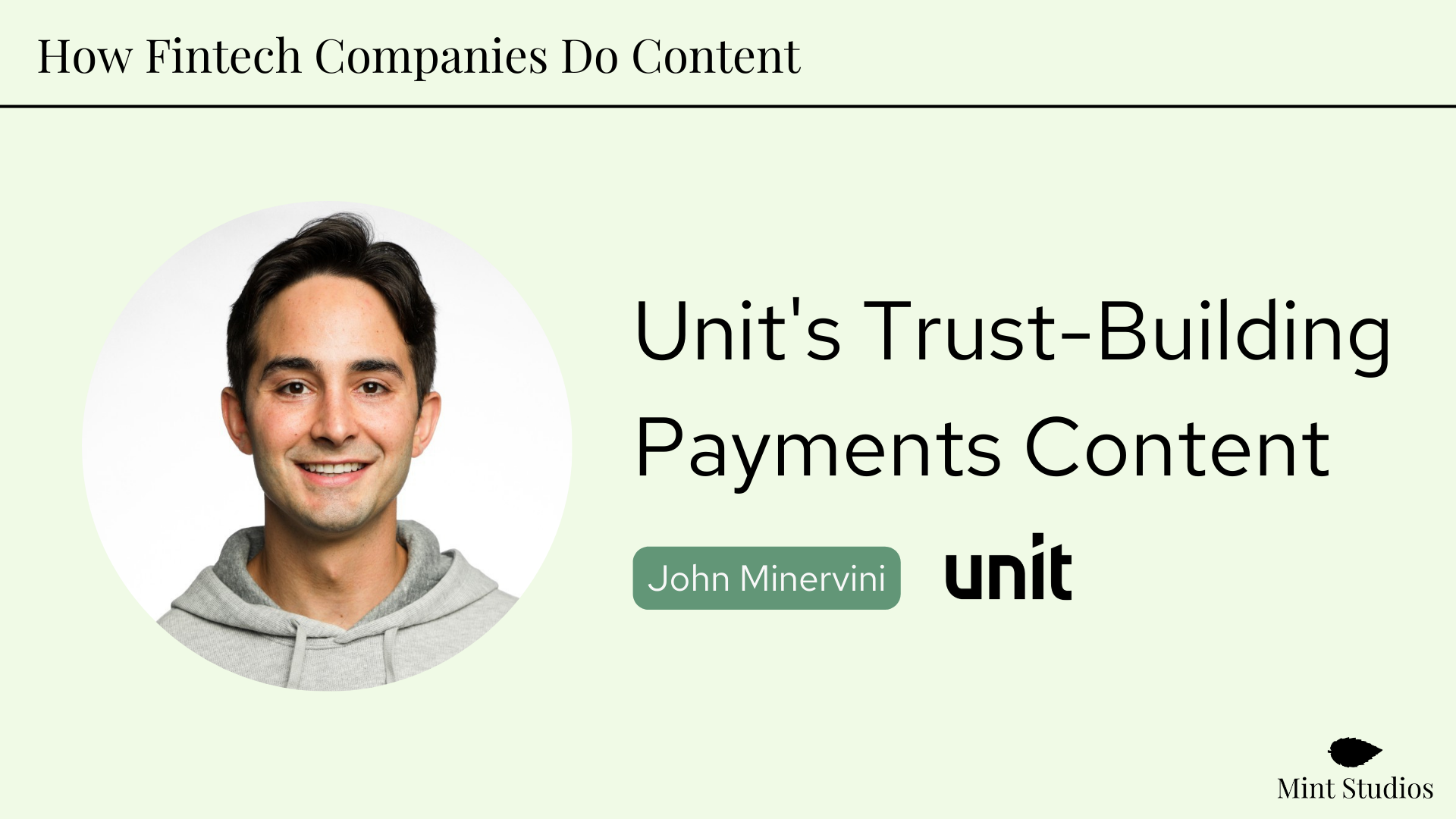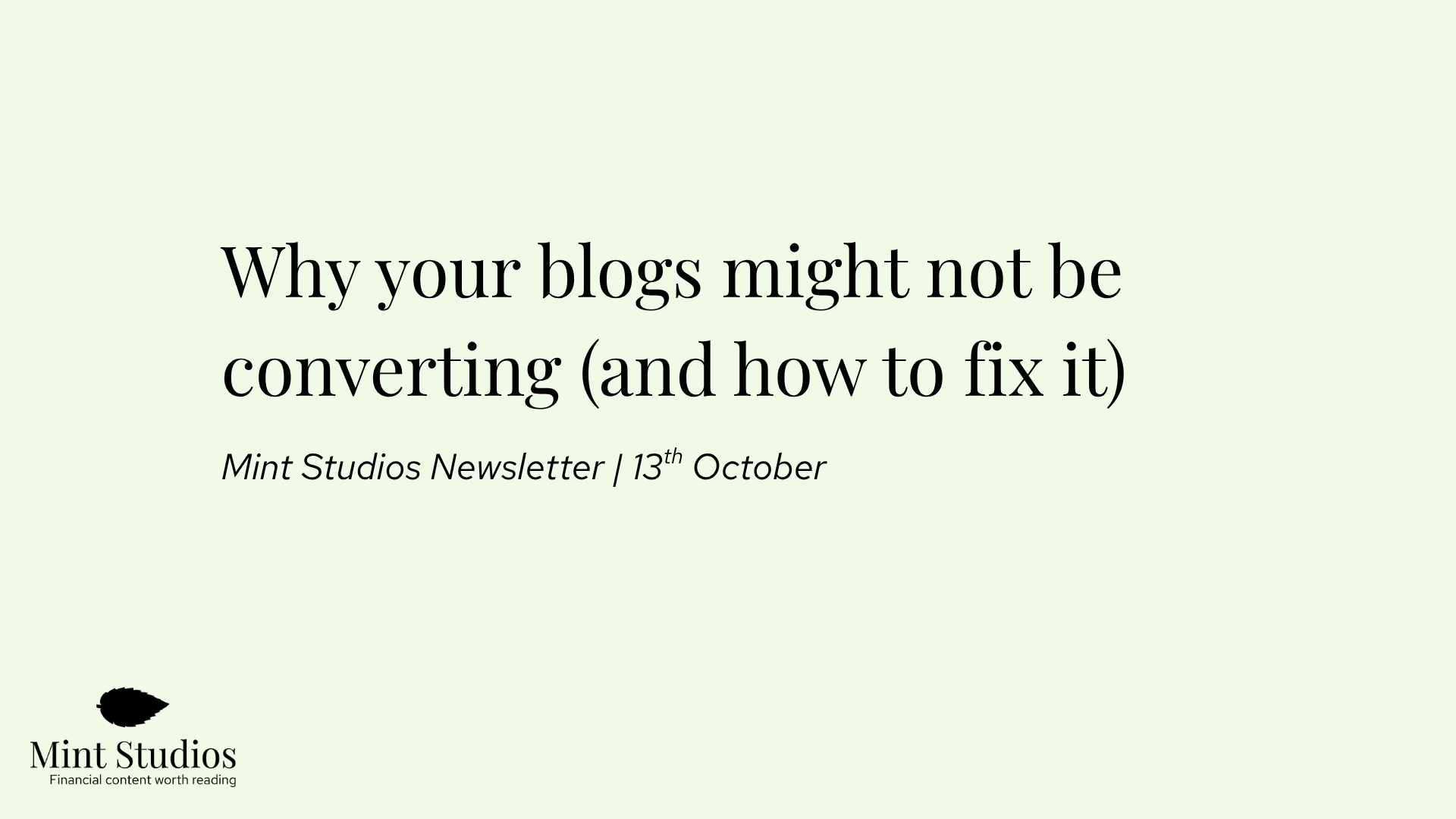“Apart from product, content is the best way for us to build trust with our target audience.”
This was the response Itai Damti, CEO and founder of Unit, gave when John Minervini, Unit’s first content marketing hire, asked why they were choosing to hire a content leader so early in the company’s trajectory. At the time, Unit was a Series B startup and John was the 25th employee.
“What I learned is that content is built into the company’s DNA,” John explains. “Itai and Doron announced the launch of Unit with a blog post in 2019, and they’ve been producing stellar content ever since.”
Today, with more than 1.5 million end-customers, over $1 billion in deposits and transaction volume reaching over $28.7 billion, Unit is the market leader in the embedded finance industry in the US.

This infographic was produced by Unit’s content team for a recent guide: How banks generate revenue from embedded finance.
Yet, Unit didn't achieve these results by producing 20 AI-generated articles per month or spending thousands of dollars chasing backlinks. Instead, their focus is on creating incredibly high-quality content via a product-based approach to content creation (which we’ll dive into later in the article).
So of course, we had to do a case study on their approach to content marketing.
We sat down with John, Unit’s Director of Content, to learn more about how Unit thinks about content, what their strategy looks like, and their process for content creation.
Note: Every couple of months throughout 2024 we’ll be releasing a new case study on how a financial services or fintech company does content. Our last one was on how Adyen creates content that sells to enterprise. Join our newsletter to make sure you get each issue in your inbox!
Unit’s story (Explaining the value of embedded finance)
Unit is a financial infrastructure platform that helps banks partner with tech companies to offer embedded financial products (e.g., high-yield accounts, business charge cards). They enable this via their platform APIs and white-label user interfaces (UIs).
Itai Damti and Doron Somech co-founded the company in 2019. But their journey starts in Israel, where they co-founded a company called Leverate, a technology provider for online brokers back in 2008. After Leverate, they reconnected to build Unit. Their goal was to build a company that would help technology companies launch rich, branded banking experiences.
“As a content marketer, you can’t fix a sub-par product,” reflects John. “So, when you’re thinking about which company to join, it’s important to prioritize companies with excellent products, products you can believe in.”

“On that count, Unit delivers,” he continues. “Itai and Doron are both experienced operators. They’ve built companies before; they have a strong product vision; and they’re shipping new code toward that vision hundreds of times per year.”
As Unit’s founding blog post explains, tech companies have a big advantage of being able to acquire customers cheaply for financial products—a challenge that many financial services organizations struggle with. Having a lower CAC means tech companies are a much better distribution channel for financial services. But most tech companies aren’t interested in becoming a bank, and Itai explains why in his launch article:
“Running and owning an actual bank is not going to be an option for the majority of US tech companies that venture into financial services, for two reasons: (1) the costs and complexity in running a bank (2) limits imposed by the US Bank Holding Company Act. They need a partner bank to rely on.”
Initially, the plan was to build a better bank. But Damti and Somech ultimately decided that, if they wanted to transform the way people consume financial services, building infrastructure would be much more impactful. So Unit became an embedded finance platform that connects tech companies to community banks. This enables tech companies to make branded cards, bank accounts, payments and lending products available on their platform. Meanwhile, it enables community banks to connect with new communities of customers and sustainably grow revenue.
Instead of taking two years and spending millions of dollars, tech companies that partner with Unit can typically launch their embedded financial products in a matter of months, for a fraction of that amount:

With Unit, community banks can generate new revenue streams, tech companies can offer a better user experience; and end-customers get access to incredible features (e.g. truck drivers can withdraw money within 5 seconds of finishing a job).
It’s a win-win-win scenario, and the Unit platform enables a big part of it.
To dive deeper into the industry and how Unit works, we highly recommend reading Packy McCormick’s in-depth essay: Absolute Unit.
We also highly recommend reading Unit’s own article about embedded finance: What is Embedded Finance.

Why content plays a key role in Unit’s marketing
The first distinctive aspect of Unit’s approach to content is the fact that it’s front and center of the business and marketing strategy.
“Our category is brand new,” John explains. “And without great content, we’ll never cross the chasm to achieve mainstream adoption.”
More specifically, content for Unit was critical because of three key reasons:
- Embedded finance is a new term and a new concept. The co-founders know that the first step toward sustainable growth is educating the market. Content is key to raising awareness and getting buy-in.
- Finance is a high-trust category. Picking an embedded finance partner is not like opening a social media account or even setting up a new CRM. Embedded finance is difficult to get right, and the consequences are dire if you don’t. Companies won’t pick an embedded finance partner based on a couple of LinkedIn ads. The entire buying committee needs to feel they can trust the company and understand how it works before working with them.
- You’re targeting people who have advanced knowledge and are making a complex decision. Unit is targeting business and product leaders who are intelligent, educated and advanced in their field, and are usually very short on time. When they have a question about payments, they want their question answered quickly, comprehensively, and from a place of authority. Well-written content written specifically for their level of knowledge does this best.
You’ve probably seen this diagram before:

At a typical startup, you would pick two of the three. For example, a content leader might prioritize lots of quick, cheap content at the expense of quality. But at Unit, they prioritize quality above all else—even sacrificing speed and cost if necessary.
“Our target audience is time-starved,” John reflects. “They typically have time to consult only one resource. They expect it to be comprehensive and authoritative.”

To make sure Unit’s content succeeds (successfully building trust by educating their demanding audience), John and his team have to maintain high standards of excellence. Content is Unit’s marketing strategy. So it has to be good.
It’s also because they’re in a highly regulated space. As John says, fintech is a unique industry where the Content Team can actually cause the whole company to fail if they say the wrong thing.
Unit’s content marketing thesis resonates with a quote by Andrew Davis: “Content builds relationships. Relationships are built on trust. Trust drives revenue.”
What does Unit’s content strategy look like?
Although Unit tracks the success of their content with numerous quantitative metrics (e.g., impressions, demo requests), their north star has always been more qualitative: the brand.
“Brand is one of those words that everyone uses, but no one agrees on what it means,” observes John. “The best definition I’ve heard is that it’s how your target audience feels about your company. It’s something that a content team can attempt to shape—but we’ll never fully control it.”
For many Unit stakeholders (e.g., tech leaders, bank executives), content is the first touchpoint they’ll have with the company—so it’s important that the content embody Unit’s brand values. That helps to build relationships of trust and teaches stakeholders what to expect from Unit in other areas.

After he joined, John worked with Unit leadership to develop a Brand Style, Voice, and Tone Guide. It’s a constantly evolving document that articulates what the company means when they refer to “good content.” It names six brand pillars that characterize Unit’s written and spoken communication:
- Precise
- Approachable
- Authoritative
- Trustworthy
- Innovative
- Simple
It’s worth noting that there are several contradictions inherent in this list—and navigating them is the job of the Content Team. The two brand pillars that are most often in conflict are “precise” and “simple”, which are constantly tugging in different directions.
“When you’re writing about things like payments, chargebacks, interchange revenue—this content is incredibly complex,” observes John. “The challenge for our team is to produce assets that answer our target audience’s questions without going into unnecessary detail.”
In addition to brand building, Unit also uses content for the following purposes::
- Lead generation (e.g., webinars, SEO)
- Sales enablement (e.g., pitch decks, custom demos)
- Help content (e.g., API docs, technical guides)
Unit’s content strategy aligns closely with the company’s business strategy and top-level goals. For example, John explains that, at present, one of Unit’s strategic focus areas is building relationships of trust with community banks. As a result, the Content Team has dedicated a significant amount of bandwidth to creating educational assets for banks.

A “product” approach to content marketing
At present, Unit’s Content Team consists of two full-time employees: John and a writer (Jennifer Lowe), who previously worked together at Plaid. To extend their capacity, they also partner with several external agencies on things like design, website development, communications, and SEO.
It’s a lean team, but they still produce a large amount of high-quality content. As Director of Content, John spends 40% of his time on strategy and project management, 40% on writing and editing, and 20% on meetings.
A key element of Unit’s content production is their “product” approach to content marketing. Before doing any writing—or even outlining—John and Jen take the time to create (and, yes, argue about) a content brief that precisely articulates two things that will guide the rest of the process:
- A target audience. Who is this asset for? What problem can we help them solve? What are their pain points? How are they measuring success? Include a LinkedIn profile if possible.
- A desired outcome. What do we want them to know, feel, and do (KFD) after they’ve interacted with this content? Each part of the KFD should be articulated as a single, short sentence.
“Content teams succeed by becoming thought leaders within their organizations, by going deep on the company’s products and markets,” observes John. “That way, when an exec asks why you wrote this versus that, why you chose to work on this asset versus that one, you’ve got a good answer.”
To illustrate how target audience and desired outcome work together to guide content creation, let’s use an example: an article the team recently published about how banks generate revenue from embedded finance. It dives deep on the two types of revenue—net interest margin and fee income—while also outlining timeframes and best practices. .
The target audience for this article is an executive at a community bank, someone who is responsible for revenue growth. The desired outcome is that the executive…
- Know that embedded finance is a sustainable way to connect with new customers and grow revenue
- Feel excited, trusting, curious, inspired…and a bit of FOMO
- Do get in touch with Unit’s Banks Team or deepen that conversation
“Once you’ve aligned on a target audience and a desired outcome, building a great content strategy is pretty straightforward,” John explains. “They’re like a compass that will guide you to the right topics, asset types, and distribution channels.”
Like other fintech marketing teams, Unit’s Content team must work closely with Compliance and Legal. Initially, the three teams had to invest heavily in building out processes and calibrating expectations. But with time, content publication has increasingly flowed smoothly. These days, Unit’s Content Team has positive working relationships with both Legal and Compliance. All three teams know that Unit must produce and publish content in order to build trust with key stakeholders and grow.
We’ve gone into more detail about managing compliance as a content marketer in this article: How to Navigate Compliance and Content Creation as a Fintech Marketer.

How does the content team stay close to customer pain points?
Creating content that connects with your target audience and achieves the desired outcome requires a deep understanding of your reader’s pain points, problems, and top questions.
Typically, tech writers are fairly far removed from prospects and customers. So how does Unit’s Content Team stay close to their target audience?
Once a week, the Content Team meets for “Gong Call Story Time”. For 45-60 minutes, the team listens to one or more recorded calls involving their target audience. They then debrief about the calls, asking questions like:
- Who is the persona?
- What questions are they asking?
- How are they measuring success?
- Where are they getting stuck?
“These calls are costly in terms of the time Jen and I are investing,” notes John. “But they’re essential to creating content that builds trust. The only way to truly understand your customers is to hear them talk about their goals and challenges—in their own voices.”
Another part of staying close to customers is “living and breathing fintech.” John and Jen are both continuous learners and are avid readers of newsletters, books and articles, as well as listeners to relevant podcasts. They particularly recommend:
- This Week in Fintech
- Fintech Brain Food
- Bits about Money
- In Fintech We Build Trust
- Rex Salisbury
- Alex Johnson
- Fintech Family Hour

From ideation to publication: how a piece of Unit content is produced
What does content velocity look like at Unit? It’s a question every content team must confront, and (obviously) there’s no right answer.
“One mistake I’ve seen in our space is publishing too much, too quickly,” John notes. “Some of our competitors have tried to churn out SEO content—but it’s low-quality, and no one wants to read it. As a result, it doesn’t rank for the intended search terms, and it ends up doing brand damage.”
At Unit, they aim to produce 10–12 pieces of long-form content per quarter, in addition to numerous smaller assets. Instead of producing as much as they can, they aim to produce the highest quality possible.
Once John and Jen have aligned on a topic for a piece of content, two subject-matter experts (SMEs) are brought in. One is typically focused on product / engineering, and the other is focused on sales / success.
Interestingly, this was exactly our recommendation in our article on how to write about payments – both your product and sales team should be involved in reviewing content: 8 Tips To Write Great Payments Content (From Writing 80+ Articles on Payments)
Once the interviews are done, the writing begins – and a lot of work goes into it. Before they share a draft with reviewers, John and Jen will typically proceed through 2–3 rounds of edits. In the approvals stage, as many as 8 people will review and sign off on a single piece of content.
“We exist in a highly regulated space, and a single misstep could have significant consequences,” reflects John. “Having multiple Unit team members review a single piece of content is costly—but the quality it ensures and the trust it builds are well worth it.”
What type of content do they create? Anything from:
- Landing pages
- Interactive content (e.g., revenue calculator)
- Research (e.g., Harris Poll survey results)
- Guides
- Blog posts
- Newsletters
- Op-eds
- Webinars
- Conferences
- Enablement content (decks, one-pagers)
- Email nurture streams
- Newsletters (two sent per month)
- Other campaigns
And that’s not even including earned media and press—articles in publications like Banking Dive and American Banker—where the Content Team has a hand in helping.

And finally, what does content distribution look like?
To explain how content helps Unit grow, John uses a framework from Emily Kramer of MKT1: fuel and engine.
“The fuel is all the stuff that you say (out loud, in writing, or visually) to your audience—whether that be short-form copy on a website, a long-form blog post, an image in an ad, or an explainer video. The engine is all of the channels and processes you use to get the fuel out to your audience, plus the tools you use and the metrics you use to track your marketing and growth efforts. When you combine the fuel and the engine, your business grows fast.” - Emily Kramer
At Unit, content is the fuel. The engine includes things like:
- SEO
- Newsletters and podcasts
- SEM / PPC
- Social media (LinkedIn and Twitter)
- Media and press
“The biggest mistake a content marketer makes is not thinking about distribution first,” opines John. “You can create the best, most targeted piece of content in the world, but if your target audience doesn’t see it, then you’ve failed.”

Unit’s content: proof that you can create readable financial content that converts
For Unit, content is not just another marketing tactic “that we have to do;” it’s a core part of their marketing and business strategy. They understand that, to build trust and raise awareness for a complex financial services product, you need to educate the reader.
They also understand that the best content isn’t generic. Rather, it’s the advanced content that goes in depth, gives actionable recommendations, and uses clear examples so the reader actually understands key concepts.
Unit has nailed advanced, technical payment content for an advanced audience, and is a role model for financial services marketers who need to produce content for complex industries. Huge thanks to John for agreeing to do this analysis and interview!











